
The Devonport mail-coach of 1837 on a postcard from the Post Office Collection / National Postal Museum above the Bath mail-coach of 1784 featured on a UK stamp in my proof-reading copy of Charles Darwin: A Celebration in Stamps
The postal strike has featured much in the news recently with some papers predicting the extinction of the Royal Mail.
Ironically one part of our forthcoming Edinburgh Zoo RZSS / Newquay Zoo collaboration on a Darwin stamp book features a section (especially useful for teachers) on postal history with lots of links to different resource websites. Darwin relied on the post for a link with his family and many correspondents on the Packet ships, the early postal system before Queen Victoria, Rowland Hill and the Penny Post which saw the Penny Black invented in 1840 just after Darwin returned from his famous HMS Beagle voyage in 1836.
An old friend Jo Butts gave me this postcard of the Devonport mail-coach 1837 years ago from the Post Office Collection / National Postal Museum in London. Luckily I rediscovered it in time for Darwin’s bicentenary year this year for display at Newquay Zoo, supporting the four unusual and thought-provoking Darwin 200 art exhibitions at Falmouth Art Gallery this year.
The painting shows the Devonport mail-coach driving through snowstorms in 1837, the year after Darwin’s arrival at Falmouth, Cornwall on October 2, 1836 and swift departure on the mail-coach home to Shrewsbury over two and a half days. Despite its Christmas card appearance (another Victorian invention), this postcard of a painting ‘after James Pollard 1837’ gives a vivid idea what winter mail-coach travel in the West country of the 1830s might have been like around the time that Queen Victoria came to the throne!
Darwin’s comments on the long coach journey home and his coach companions are recorded in his Beagle diary, available www.darwin-online.org.uk which, along with www.darwinproject.ac.uk , make Darwin’s writings and letters available and accessible online.
Teaching tips:
Victorians, postage and Darwin feature in primary school National Curriculum History topics, as well as Victorian discoveries and inventions in Science, Design and Technology
Teachers might consider with pupils in what other ways people communicate today, as well as posted letters, compared to Darwin’s time.
What evolution of everyday technology has replaced handwritten letter post since 1837?
How might Postman Pat (or his Victorian great great great Grandfather) have delivered Darwin’s letters then? Today his vehicles now extend past Victorian steam trains to helicopters and motorbikes as seen on www.postmanpat.com! (N.B. other children’s television characters are available).
Some of these communication methods have now become extinct or obsolete themselves such as Morse Code and telegraphs (see the website of the Porthcurno Telegraph Museum in Cornwall http://www.porthcurno.org.uk/ for more about the ‘Victorian Internet’ as it was called).
Teachers might also consider how post is delivered today instead of by horse and coach, an example of evolving technology. The old out of print Ladybird book of The Postman is a good source of colourful illustrations of postmen for use in class – easily available on E-Bay!
A postal timeline is a useful way to show this as a display, alongside Darwin’s life time line. It makes a pleasant change from studying Florence Nightingale!
